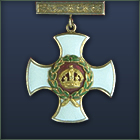The Distinguished Service Order
The Distinguished Service Order Origin and History

The Distinguished Service Order (DSO) was founded by Queen Victoria in 1886. It was established for rewarding individual instances of gallantry or distinguished service in war. The military order was awarded to military officers only, and was normally given for service under fire or in conditions equivalent to serving in actual combat with the enemy between 1914 and 1916. However, the DSO was awarded under circumstances which could not be considered as under fire. As a result, after 1 January 1917 commanders in the field were instructed to recommend this award to those serving under fire.
Prior to 1943, the DSO could only be given to someone “mentioned-in-dispatches”, and generally only to those officers in command above the rank of Lieutenant Colonel. The DSO was also awarded to those of ranks below this for acts which displayed a high degree of gallantry just short of deserving the Victoria Cross.
A plain gold bar is awarded for an act which would have earned the DSO in the first place. This bar has an imperial Crown in the centre and the year of the awarded engraved on the reverse.
The medal is a gold cross, enamelled white and edged in gold, the obverse has an imperial crown in gold upon a red enamelled ground. The crown is in the centre, within a wreath of laurel, enamelled green. The reverse of the cross contains the royal Cypher in gold upon a red enamelled ground. The Cypher is within a wreath of laurel, enamelled green.
A ring at the top of the medal attaches to a ring at the bottom of a gold bar, ornamented with laurel. At the top of the ribbon is a second gold bar ornamented with laurel. The red ribbon is 1.123 inches wide with narrow blue edges. A rosette is worn on the ribbon in undress to signify the award of a bar.
In total, 1,220 distinguished service orders have been awarded to Canadians, plus 119 first bars and 20 second bars.










